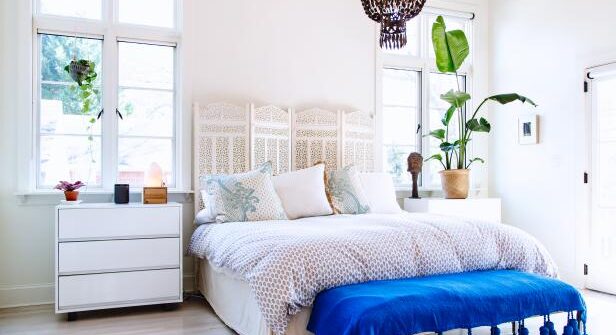Crafting Comfort: DIY Wood Round Headboards
Welcome to the world of DIY bedroom designing, where creativity meets functionality. One of the most impactful ways to personalize your bedroom is by creating a unique headboard. Our focus today is on wood round headboards, an emerging interior design trend that adds a rustic charm and warmth to any bedroom. These headboards, crafted from rounds of wood cut from tree trunks or branches, offer a unique aesthetic that can range from sleek and modern to cozy and rustic, depending on how you choose to style them.
Whether you’re a seasoned DIY bedroom designing enthusiast or a novice looking for an exciting project, these wood round headboard ideas will inspire you to transform your interior design. Not only will you get the satisfaction of creating something with your own hands, but you’ll also end up with a one-of-a-kind piece that reflects your personal style.
So, let’s roll up our sleeves and dive into the world of DIY wood round headboards.
- Rustic Lodge Headboard
Inspired by the cozy charm of a rustic lodge, this headboard design involves arranging wood rounds in an organic pattern on a sturdy base. Each round is carefully sanded and sealed to preserve its natural beauty. This headboard idea works great for those who love a touch of nature in their interiors.
- Half Circle Upholstered Headboard
Here, the wood rounds form a stunning half-circle pattern on an upholstered base, creating a statement piece for your bedroom. The contrast between the soft upholstery and the hardwood rounds adds interest and texture.
- Arched Wood Round Headboard
This design features an arched headboard made from wood rounds. The arch shape adds a unique architectural element to the bedroom, while the wood rounds bring in a rustic vibe. It’s a perfect blend of modern and rustic styles.
- Easy Wooden Headboard
This is a simple yet stylish headboard idea where wood rounds are arranged in rows on a flat base. The design is versatile and can easily fit into any decor style. It’s an easy DIY for beginners who want to start their journey into woodworking.
- Arch Headboard with Cane Detailing
In this design, wood rounds are paired with cane detailing to create an arch-shaped headboard. The mix of materials adds a boho-chic vibe to the bedroom. A blend of traditional and modern, this headboard is sure to make a statement.
- Easy Build Wood Headboard
This design involves creating a headboard from wood rounds of different sizes for a unique texture and depth. It’s an easy build, requiring common materials like wood glue and sandpaper. The end result is a stunning headboard that can fit any mattress size.
These DIY wood round headboard design ideas are not just about adding a personal touch to your bedroom, but also about the joy of creating something unique and beautiful with your own hands. From rustic lodge-inspired bedroom designing to modern arches with cane detailing, there’s an idea for every style and skill level. So why not give it a go? With a bit of creativity and effort, you can transform your bedroom into a stylish sanctuary that reflects your personality and aesthetic. Happy crafting!















